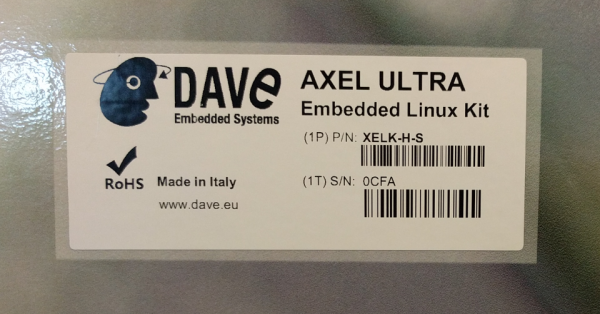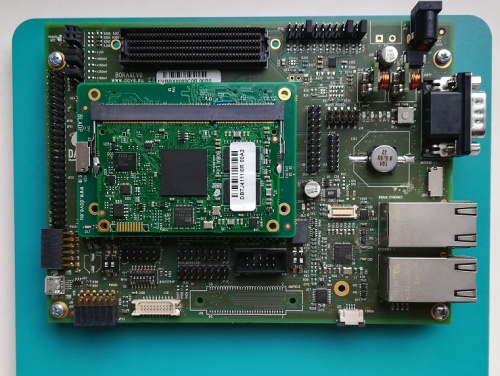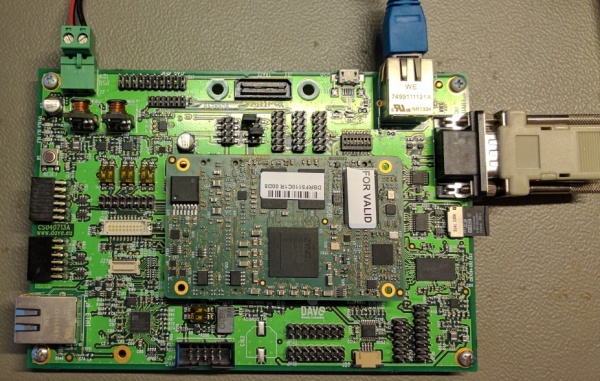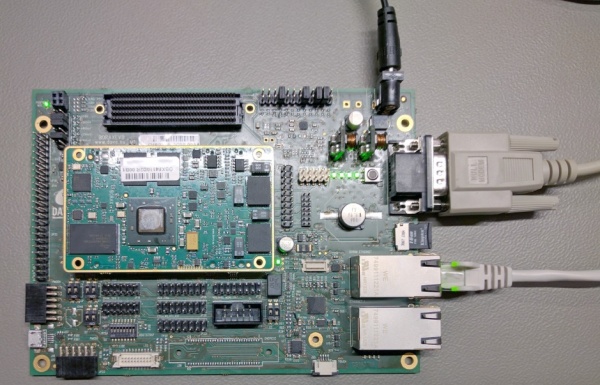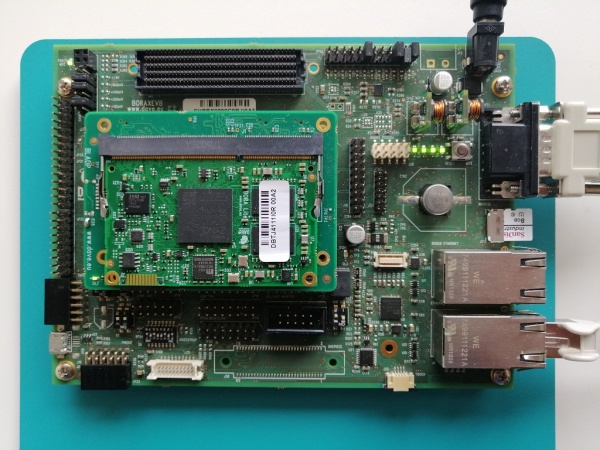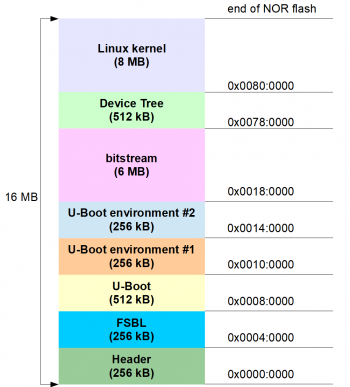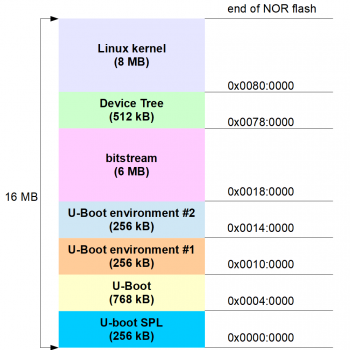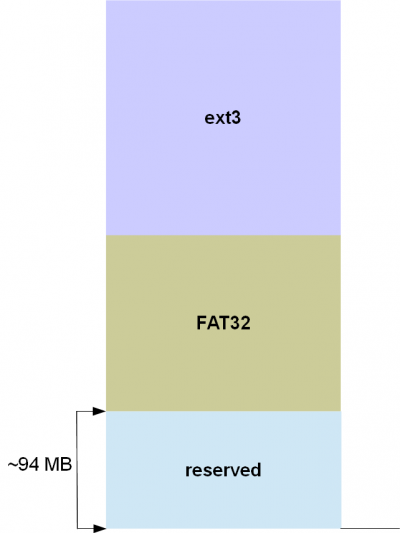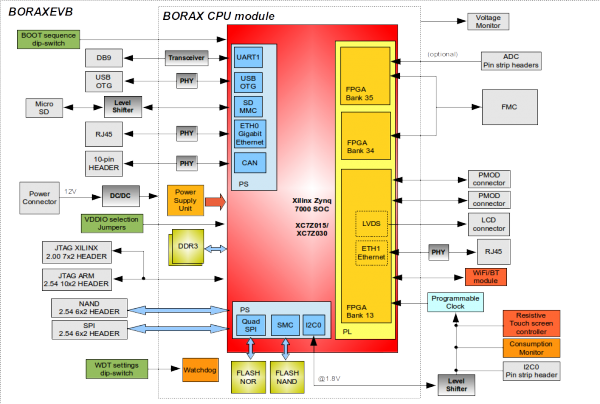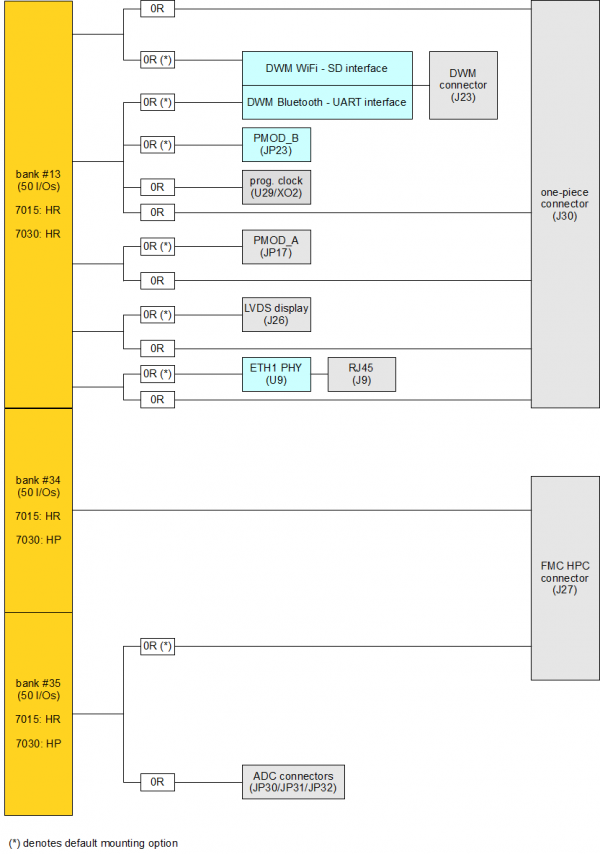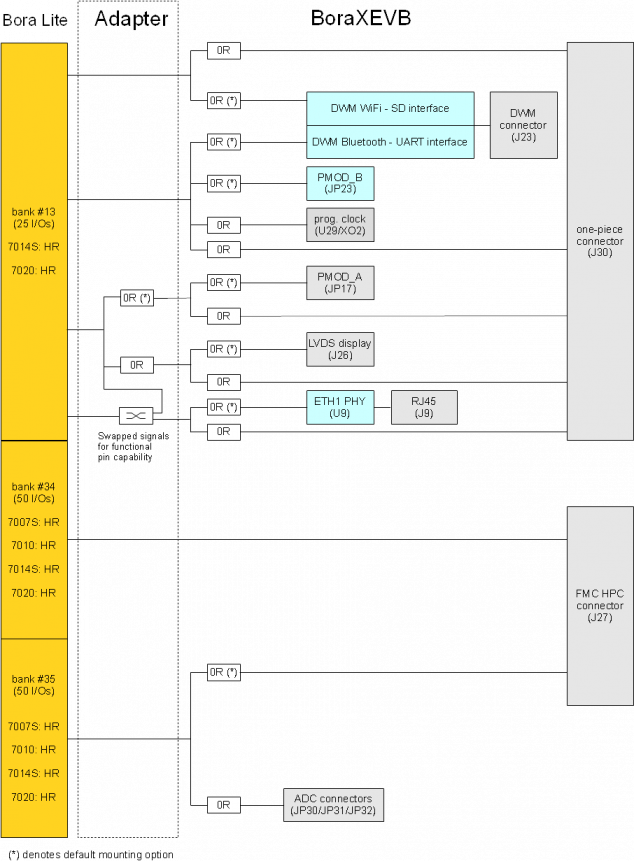BORA Lite SOM/BORA Lite Evaluation Kit/pdf
Getting started[edit | edit source]
Kit Identification Codes[edit | edit source]
The development kits (DESK, XELK, XUELK, BELK, etc.) are identified by a couple of codes:
- P/N Part Number identification code
- S/N Serial Number identification code
These codes are printed on a label sticked to the box containing the kit.
For example, the following picture shows such a label of an AXEL Ultra XELK (XELK-H-S) with Serial Number 0CFA
These codes are required to complete the registration process of the kit.
Unboxing[edit | edit source]
Once you've received the kit, please open the box and check the kit contents with the packing list included in the box, using the table on this chapter as a reference.
The hardware components (SOM, carrier boards and display) are pre-assembled, as shown in the picture below:
Kit Contents[edit | edit source]
| Component | Description | Notes |
|---|---|---|
BoraLite SOM (p/n DBTD4111I0R)
|
||
| BoraXEVB BoraLite Adapter board | ||
| BoraXEVB carrier board | ||
| AC/DC Single Output Wall Mount adapter Output: +12V – 2.0 A |
||

|
microSDHC card with SD adapter and USB adapter |
Order codes[edit | edit source]
| Order code | Description |
|---|---|
| BTELK-L-S | This code refers to the default configuration detailed above |
microSD Layout[edit | edit source]
The microSD provided with the kit is used to store:
- a bootable partition (mmcblk0p1, vfat) containing:
- binary images (u-boot and kernel images)
- root file system partition (mmcblk0p2, ext4)
Target setup and first boot[edit | edit source]
This section describes how to quickly start Bora/BoraEVB and BoraX/BoraXEVB systems included in the BELK/BXELK:
- on target side, connect a null-modem cable on J17 DB9 connector, denoted also as UART1
- on host side, connect the other end of the null-modem cable to a COM port and start your favorite terminal software that will be used to interact with the target's serial console; communication parameters are 115200-8-N-1
- optionally connect the BoraEVB/BoraXEVB board to an Ethernet LAN by plugging cable into connector J8, also denoted as ETH0 on BoraEVB and BORAX ETHERNET on BoraXEVB
- connect 12V power supply to JP2 or J7 connector, also denoted as PSU 12V
- insert the microSD card in the slot J21, also denoted as MICROSD.
Once power has been applied to the target, FSBL or U-boot SPL and U-Boot bootloaders will be fetched from the SPI NOR flash that equips Bora/BoraX/BORA Lite SOM and executed. Boot messages will be printed out to the serial console. Redundant U-Boot environment is stored in the NOR flash as well, as depicted in the following image.
By default, U-Boot is configured to retrieve Linux kernel image stored in the microSD card [1]. In turn, Linux kernel shall mount root file system from the mmcblk0p2 partition of the microSD card itself [2], [3]. At the end of boot process, Linux shell shall be available on the serial console. Default boot process does not download any bitstream to the Programmable Logic.
The following dump shows the typical messages printed out to the console during bootstrap process. This log refers to Belk-4.0.0 running on BORA SOM. For BORAX SOM similar messages are printed out to the console.
U-Boot SPL 2017.01-belk-4.0.0 (Jul 11 2017 - 15:58:04)
qspi boot
Trying to boot from SPI
U-Boot 2017.01-belk-4.0.0 (Jul 11 2017 - 15:58:04 +0200), Build: jenkins-BELK_u-boot-10
Model: Bora
Board: Xilinx Zynq
I2C: ready
DRAM: ECC disabled 1 GiB
Relocating to 3ff2e000, new gd at 3eaedee8, sp at 3eaedec0
NAND: 1024 MiB
MMC: sdhci@e0100000: 0 (SD)
SF: Detected s25fl256s_64k with page size 256 Bytes, erase size 64 KiB, total 64 MiB
*** Warning - bad CRC, using default environment
In: serial@e0001000
Out: serial@e0001000
Err: serial@e0001000
Model: Bora
Board: Xilinx Zynq
SF: Detected s25fl256s_64k with page size 256 Bytes, erase size 64 KiB, total 64 MiB
SF: Detected s25fl256s_64k with page size 256 Bytes, erase size 64 KiB, total 64 MiB
SOM ConfigID#: 00000001
SOM UniqueID#: 01234567:89abcdef
ds2431_readmem(): error in chip reset
ds2431_readmem(): error in reading buffer
ds2431_readmem(): error in chip reset
ds2431_readmem(): error in reading buffer
CB ConfigID CRC mismatch for 0x00000000 (was 0x00000000, expected 0x2144df1c) at block 3 (offset 96): using default
CB ConfigID#: ffffffff
CB UniqueID#: 00000000:00000000
Net: ZYNQ GEM: e000b000, phyaddr 7, interface rgmii-id
eth0: ethernet@e000b000
Hit ENTER within 3 seconds to stop autoboot
starting USB...
USB0: USB EHCI 1.00
scanning bus 0 for devices... 1 USB Device(s) found
scanning usb for storage devices... 0 Storage Device(s) found
USB device 0: unknown device
** Bad device usb 0 **
switch to partitions #0, OK
mmc0 is current device
reading boot.scr
472 bytes read in 12 ms (38.1 KiB/s)
Running bootscript from mmc ...
## Executing script at 02080000
bootscript generated with command "mkimage -A ARM -T script -C none -n BELK -d bootscript.txt boot.scr"
reading uImage
3770880 bytes read in 642 ms (5.6 MiB/s)
reading bora.dtb
10647 bytes read in 19 ms (546.9 KiB/s)
Booting Bora/BoraX via mmc
## Error: "configid_fixup" not defined
## Booting kernel from Legacy Image at 02080000 ...
Image Name: Linux-4.9.0-belk-4.0.0-xilinx
Image Type: ARM Linux Kernel Image (uncompressed)
Data Size: 3770816 Bytes = 3.6 MiB
Load Address: 00008000
Entry Point: 00008000
Verifying Checksum ... OK
## Flattened Device Tree blob at 02000000
Booting using the fdt blob at 0x2000000
Loading Kernel Image ... OK
Loading Device Tree to 1effa000, end 1efff996 ... OK
Switching to NAND storage before starting Linux
Starting kernel ...
Uncompressing Linux... done, booting the kernel.
[ 0.000000] Booting Linux on physical CPU 0x0
[ 0.000000] Linux version 4.9.0-belk-4.0.0-xilinx (jenkins@linuxserver2) (gcc version 6.2.1 20161016 (Linaro GCC 6.2-2016.11) ) #1 SMP PREEMPT Sun Jul 9 23:10:22 CEST 2017
[ 0.000000] CPU: ARMv7 Processor [413fc090] revision 0 (ARMv7), cr=18c5387d
[ 0.000000] CPU: PIPT / VIPT nonaliasing data cache, VIPT aliasing instruction cache
[ 0.000000] OF: fdt:Machine model: Bora
[ 0.000000] bootconsole [earlycon0] enabled
[ 0.000000] cma: Reserved 16 MiB at 0x3f000000
[ 0.000000] Memory policy: Data cache writealloc
[ 0.000000] On node 0 totalpages: 262144
[ 0.000000] free_area_init_node: node 0, pgdat c0a2d840, node_mem_map ef7f7000
[ 0.000000] Normal zone: 1536 pages used for memmap
[ 0.000000] Normal zone: 0 pages reserved
[ 0.000000] Normal zone: 196608 pages, LIFO batch:31
[ 0.000000] HighMem zone: 65536 pages, LIFO batch:15
[ 0.000000] percpu: Embedded 14 pages/cpu @ef7d1000 s26124 r8192 d23028 u57344
[ 0.000000] pcpu-alloc: s26124 r8192 d23028 u57344 alloc=14*4096
[ 0.000000] pcpu-alloc: [0] 0 [0] 1
[ 0.000000] Built 1 zonelists in Zone order, mobility grouping on. Total pages: 260608
[ 0.000000] Kernel command line: root=/dev/mmcblk0p2 rootwait rw console=ttyPS0,115200n8 debug earlyprintk
[ 0.000000] PID hash table entries: 4096 (order: 2, 16384 bytes)
[ 0.000000] Dentry cache hash table entries: 131072 (order: 7, 524288 bytes)
[ 0.000000] Inode-cache hash table entries: 65536 (order: 6, 262144 bytes)
[ 0.000000] Memory: 1013220K/1048576K available (6144K kernel code, 232K rwdata, 1512K rodata, 1024K init, 323K bss, 18972K reserved, 16384K cma-reserved, 245760K highmem)
[ 0.000000] Virtual kernel memory layout:
[ 0.000000] vector : 0xffff0000 - 0xffff1000 ( 4 kB)
[ 0.000000] fixmap : 0xffc00000 - 0xfff00000 (3072 kB)
[ 0.000000] vmalloc : 0xf0800000 - 0xff800000 ( 240 MB)
[ 0.000000] lowmem : 0xc0000000 - 0xf0000000 ( 768 MB)
[ 0.000000] pkmap : 0xbfe00000 - 0xc0000000 ( 2 MB)
[ 0.000000] modules : 0xbf000000 - 0xbfe00000 ( 14 MB)
[ 0.000000] .text : 0xc0008000 - 0xc0700000 (7136 kB)
[ 0.000000] .init : 0xc0900000 - 0xc0a00000 (1024 kB)
[ 0.000000] .data : 0xc0a00000 - 0xc0a3a1a0 ( 233 kB)
[ 0.000000] .bss : 0xc0a3a1a0 - 0xc0a8afb4 ( 324 kB)
[ 0.000000] Preemptible hierarchical RCU implementation.
[ 0.000000] Build-time adjustment of leaf fanout to 32.
[ 0.000000] RCU restricting CPUs from NR_CPUS=4 to nr_cpu_ids=2.
[ 0.000000] RCU: Adjusting geometry for rcu_fanout_leaf=32, nr_cpu_ids=2
[ 0.000000] NR_IRQS:16 nr_irqs:16 16
[ 0.000000] efuse mapped to f0802000
[ 0.000000] slcr mapped to f0804000
[ 0.000000] L2C: platform modifies aux control register: 0x02060000 -> 0x02460000
[ 0.000000] L2C: DT/platform modifies aux control register: 0x02060000 -> 0x02460000
[ 0.000000] L2C-310 erratum 769419 enabled
[ 0.000000] L2C-310 enabling early BRESP for Cortex-A9
[ 0.000000] L2C-310 full line of zeros enabled for Cortex-A9
[ 0.000000] L2C-310 dynamic clock gating enabled, standby mode enabled
[ 0.000000] L2C-310 cache controller enabled, 8 ways, 512 kB
[ 0.000000] L2C-310: CACHE_ID 0x410000c8, AUX_CTRL 0x46460001
[ 0.000000] zynq_clock_init: clkc starts at f0804100
[ 0.000000] Zynq clock init
[ 0.000000] ps_clk frequency not specified, using 33 MHz.
[ 0.000012] sched_clock: 64 bits at 333MHz, resolution 3ns, wraps every 4398046511103ns
[ 0.007870] clocksource: arm_global_timer: mask: 0xffffffffffffffff max_cycles: 0x4ce07af025, max_idle_ns: 440795209040 ns
[ 0.018886] Switching to timer-based delay loop, resolution 3ns
[ 0.024887] clocksource: ttc_clocksource: mask: 0xffff max_cycles: 0xffff, max_idle_ns: 537538477 ns
[ 0.033937] timer #0 at f080c000, irq=17
[ 0.038252] Console: colour dummy device 80x30
[ 0.042581] Calibrating delay loop (skipped), value calculated using timer frequency.. 666.66 BogoMIPS (lpj=3333333)
[ 0.053061] pid_max: default: 32768 minimum: 301
[ 0.057843] Mount-cache hash table entries: 2048 (order: 1, 8192 bytes)
[ 0.064345] Mountpoint-cache hash table entries: 2048 (order: 1, 8192 bytes)
[ 0.071973] CPU: Testing write buffer coherency: ok
[ 0.076890] CPU0: thread -1, cpu 0, socket 0, mpidr 80000000
[ 0.082484] Setting up static identity map for 0x100000 - 0x100058
[ 0.258340] CPU1: thread -1, cpu 1, socket 0, mpidr 80000001
[ 0.258442] Brought up 2 CPUs
[ 0.266979] SMP: Total of 2 processors activated (1333.33 BogoMIPS).
[ 0.273360] CPU: All CPU(s) started in SVC mode.
[ 0.278941] devtmpfs: initialized
[ 0.285288] VFP support v0.3: implementor 41 architecture 3 part 30 variant 9 rev 4
[ 0.293052] clocksource: jiffies: mask: 0xffffffff max_cycles: 0xffffffff, max_idle_ns: 19112604462750000 ns
[ 0.303669] pinctrl core: initialized pinctrl subsystem
[ 0.310015] NET: Registered protocol family 16
[ 0.316110] DMA: preallocated 256 KiB pool for atomic coherent allocations
[ 0.358364] cpuidle: using governor ladder
[ 0.398352] cpuidle: using governor menu
[ 0.414905] hw-breakpoint: found 5 (+1 reserved) breakpoint and 1 watchpoint registers.
[ 0.422775] hw-breakpoint: maximum watchpoint size is 4 bytes.
[ 0.428739] zynq-ocm f800c000.ocmc: ZYNQ OCM pool: 256 KiB @ 0xf0880000
[ 0.435584] zynq-pinctrl 700.pinctrl: zynq pinctrl initialized
[ 0.455610] vgaarb: loaded
[ 0.458851] SCSI subsystem initialized
[ 0.462817] usbcore: registered new interface driver usbfs
[ 0.468276] usbcore: registered new interface driver hub
[ 0.473587] usbcore: registered new device driver usb
[ 0.479680] pps_core: LinuxPPS API ver. 1 registered
[ 0.484514] pps_core: Software ver. 5.3.6 - Copyright 2005-2007 Rodolfo Giometti <giometti@linux.it>
[ 0.493700] PTP clock support registered
[ 0.499357] clocksource: Switched to clocksource arm_global_timer
[ 0.520290] NET: Registered protocol family 2
[ 0.525350] TCP established hash table entries: 8192 (order: 3, 32768 bytes)
[ 0.532409] TCP bind hash table entries: 8192 (order: 4, 65536 bytes)
[ 0.538840] TCP: Hash tables configured (established 8192 bind 8192)
[ 0.545202] UDP hash table entries: 512 (order: 2, 16384 bytes)
[ 0.551082] UDP-Lite hash table entries: 512 (order: 2, 16384 bytes)
[ 0.557542] NET: Registered protocol family 1
[ 0.562207] RPC: Registered named UNIX socket transport module.
[ 0.567985] RPC: Registered udp transport module.
[ 0.572752] RPC: Registered tcp transport module.
[ 0.577445] RPC: Registered tcp NFSv4.1 backchannel transport module.
[ 0.583922] PCI: CLS 0 bytes, default 64
[ 0.588414] hw perfevents: enabled with armv7_cortex_a9 PMU driver, 7 counters available
[ 0.598056] futex hash table entries: 512 (order: 3, 32768 bytes)
[ 0.604966] workingset: timestamp_bits=30 max_order=18 bucket_order=0
[ 0.612013] jffs2: version 2.2. (NAND) (SUMMARY) © 2001-2006 Red Hat, Inc.
[ 0.619910] bounce: pool size: 64 pages
[ 0.623630] io scheduler noop registered
[ 0.627583] io scheduler deadline registered
[ 0.631928] io scheduler cfq registered (default)
[ 0.639167] dma-pl330 f8003000.dmac: Loaded driver for PL330 DMAC-241330
[ 0.645763] dma-pl330 f8003000.dmac: DBUFF-128x8bytes Num_Chans-8 Num_Peri-4 Num_Events-16
[ 0.654861] e0000000.serial: ttyPS1 at MMIO 0xe0000000 (irq = 145, base_baud = 3125000) is a xuartps
[ 0.664307] e0001000.serial: ttyPS0 at MMIO 0xe0001000 (irq = 146, base_baud = 3125000) is a xuartps
à[ 0.673432] console [ttyPS0] enabled
[ 0.673432] console [ttyPS0] enabled
[ 0.680527] bootconsole [earlycon0] disabled
[ 0.680527] bootconsole [earlycon0] disabled
[ 0.689751] xdevcfg f8007000.devcfg: ioremap 0xf8007000 to f086f000
[ 0.696648] [drm] Initialized
[ 0.712609] brd: module loaded
[ 0.723100] loop: module loaded
[ 0.728406] libphy: Fixed MDIO Bus: probed
[ 0.735460] CAN device driver interface
[ 0.741807] libphy: MACB_mii_bus: probed
[ 0.840108] macb e000b000.ethernet eth0: Cadence GEM rev 0x00020118 at 0xe000b000 irq 148 (00:50:c2:1e:af:e0)
[ 0.849977] Micrel KSZ9031 Gigabit PHY e000b000.etherne:07: attached PHY driver [Micrel KSZ9031 Gigabit PHY] (mii_bus:phy_addr=e000b000.etherne:07, irq=-1)
[ 0.864140] e1000e: Intel(R) PRO/1000 Network Driver - 3.2.6-k
[ 0.869913] e1000e: Copyright(c) 1999 - 2015 Intel Corporation.
[ 0.876782] ehci_hcd: USB 2.0 'Enhanced' Host Controller (EHCI) Driver
[ 0.883279] ehci-pci: EHCI PCI platform driver
[ 0.887820] usbcore: registered new interface driver usb-storage
[ 0.894012] e0002000.usb supply vbus not found, using dummy regulator
[ 0.900703] ULPI transceiver vendor/product ID 0x0424/0x0006
[ 0.906275] Found SMSC USB331x ULPI transceiver.
[ 0.910910] ULPI integrity check: passed.
[ 0.916630] mousedev: PS/2 mouse device common for all mice
[ 0.922521] i2c /dev entries driver
[ 0.926190] cdns-i2c e0004000.i2c: 100 kHz mmio e0004000 irq 142
[ 0.933517] rtc-ds3232 0-0068: oscillator discontinuity flagged, time unreliable
[ 0.943182] rtc-ds3232 0-0068: rtc core: registered ds3232 as rtc0
[ 0.950800] ina2xx 0-0041: power monitor ina226 (Rshunt = 10000 uOhm)
[ 0.959126] Xilinx Zynq CpuIdle Driver started
[ 0.964011] sdhci: Secure Digital Host Controller Interface driver
[ 0.970180] sdhci: Copyright(c) Pierre Ossman
[ 0.974447] sdhci-pltfm: SDHCI platform and OF driver helper
[ 1.039420] mmc0: SDHCI controller on e0100000.sdhci [e0100000.sdhci] using DMA
[ 1.047063] usbcore: registered new interface driver usbhid
[ 1.053610] usbhid: USB HID core driver
[ 1.060557] nand: device found, Manufacturer ID: 0x01, Chip ID: 0xd3
[ 1.066828] nand: AMD/Spansion S34ML08G1
[ 1.070797] nand: 1024 MiB, SLC, erase size: 128 KiB, page size: 2048, OOB size: 64
[ 1.079104] Bad block table found at page 524224, version 0x01
[ 1.086183] Bad block table found at page 524160, version 0x01
[ 1.092800] 8 ofpart partitions found on MTD device pl35x-nand
[ 1.098568] Creating 8 MTD partitions on "pl35x-nand":
[ 1.103708] 0x000000000000-0x000000040000 : "nand-SPL"
[ 1.120695] 0x000000040000-0x000000100000 : "nand-uboot"
[ 1.137009] 0x000000100000-0x000000140000 : "nand-uboot-env1"
[ 1.153846] 0x000000140000-0x000000180000 : "nand-uboot-env2"
[ 1.160646] mmc0: new SDHC card at address 0001
[ 1.165619] mmcblk0: mmc0:0001 SD16G 14.6 GiB
[ 1.170685] 0x000000180000-0x000000780000 : "nand-bitstream"
[ 1.177693] 0x000000780000-0x000000800000 : "nand-device-tree"
[ 1.183599] mmcblk0: p1 p2
[ 1.194709] 0x000000800000-0x000001000000 : "nand-linux"
[ 1.211164] 0x000001000000-0x000020000000 : "nand-rootfs"
[ 1.232466] NET: Registered protocol family 17
[ 1.236842] can: controller area network core (rev 20120528 abi 9)
[ 1.243084] NET: Registered protocol family 29
[ 1.247450] can: raw protocol (rev 20120528)
[ 1.251720] can: broadcast manager protocol (rev 20161123 t)
[ 1.257345] can: netlink gateway (rev 20130117) max_hops=1
[ 1.263160] Registering SWP/SWPB emulation handler
[ 1.274219] rtc-ds3232 0-0068: hctosys: unable to read the hardware clock
[ 1.283162] EXT4-fs (mmcblk0p2): mounting ext3 file system using the ext4 subsystem
[ 1.592447] random: fast init done
[ 1.748727] EXT4-fs (mmcblk0p2): recovery complete
[ 1.756780] EXT4-fs (mmcblk0p2): mounted filesystem with ordered data mode. Opts: (null)
[ 1.764840] VFS: Mounted root (ext3 filesystem) on device 179:2.
[ 1.775504] devtmpfs: mounted
[ 1.781627] Freeing unused kernel memory: 1024K (c0900000 - c0a00000)
INIT: version 2.88 booting
Starting udev
[ 2.706500] udevd[702]: starting version 3.2
[ 2.771034] udevd[703]: starting eudev-3.2
[ 2.915949] EXT4-fs (mmcblk0p2): re-mounted. Opts: (null)
Mon Jul 3 00:01:52 UTC 2017
INIT: Entering runlevel: 5
Configuring network interfaces... udhcpc (v1.24.1) started
Sending discover...
Sending discover...
Sending discover...
No lease, forking to background
done.
Starting system message bus: dbus.
Starting Dropbear SSH server: dropbear.
Starting rpcbind daemon...done.
starting statd: done
exportfs: can't open /etc/exports for reading
NFS daemon support not enabled in kernel
Starting syslogd/klogd: done
Starting internet superserver: xinetd.
* Starting Avahi mDNS/DNS-SD Daemon: avahi-daemon
...done.
Starting tcf-agent: OK
Poky (Yocto Project Reference Distro) 2.2.1 bora /dev/ttyPS0
bora login:
[1] bootscript is used to do this task.
[2] This root file system has been generated by Yocto build system.
[3] The microSD card is bootable itself, as explained here.
microSD layout[edit | edit source]
The microSD card provided with BELK/BXELK is partitioned as shown in the following image:
Most of storage space is occupied by two partitions:
- a
FAT32partition (mmcblk0p1) containing:- For BELK <= 3.0.2 and BXELK <= 1.0.1 :
boot.binboot image (containing FSBL, FPGA Bitstream an U-boot binaries)- U-Boot
boot.scrbootscript - Linux kernel and DTB binary images
- For BELK 4.0.0 or newer and BXELK 2.0.0 or newer:
boot.binu-boot SPL imagefpga.bitoptional FPGA bitstreamu-boot.imgu-boot image- U-Boot
boot.scrbootscript - Linux kernel and DTB binary images
- MVM image in OVA format
- For BELK <= 3.0.2 and BXELK <= 1.0.1 :
- an
ext3partition (mmcblk0p2) containing the root file system for the target.
bootscript and root file system are used to boot the target as described in this section.
It is worth remembering that the microSD card is bootable and U-Boot environment is retrieved from (and stored to with saveenv) into the FAT partition as bora.env
Boot mode selection - S5[edit | edit source]
S5 is a dip-switch for the boot mode selection. The following table reports the available options and the related configurations:
| S5.1 | S5.2 | S5.3 | S5.4 | S5.5 | S5.6 | S5.7 | S5.8 | |
|---|---|---|---|---|---|---|---|---|
| SPI-NOR | OFF | ON | OFF | ON | ON | ON | ON | OFF |
| SD-card | OFF | ON | OFF | ON | ON | OFF | ON | OFF |
| NAND (*) | OFF | ON | OFF | ON | ON | OFF | ON | ON |
| JTAG | OFF | ON | OFF | ON | ON | ON | ON | ON |
(*) Boot mode from NAND in supported ONLY on BORA Lite SOM module
Reset button - S6[edit | edit source]
S6 is the hardware reset button connected to the MRSTn signal (J2.16 SOM connector)
General Information[edit | edit source]
Product Highlights[edit | edit source]
The BORA Lite Evaluation Board platform presented here provides a compact solution for evaluating the BORA Lite SOM performances and connection capability.
The following table summarizes the main hardware and software features available with BoraXEVB:
Hardware[edit | edit source]
| Subsystem | Characteristics |
|---|---|
| CPU | Zynq 7000 Dual Core Cortex-A7 |
| SD | microSD boot device |
| USB | OTG |
| Serial Ports | RS232 CAN interface |
| Ethernet | Dual EMAC 10/100/1000Mbps |
| Display | LVDS interface |
| Touchscreen | Resistive |
| Espansion | FMC connector |
| PSU | 12 to 24V DC |
Software[edit | edit source]
| Subsystem | Options |
|---|---|
| Operating System | Linux |
| Distribution | Yocto, Petalinux |
| Applications | SoftPLC |
Block Diagram[edit | edit source]
The following picture shows BORA Xpress EVB block diagram:
Configurable routing options[edit | edit source]
FPGA banks #12, #34 and #35 supports different routing options as shown in the following picture.
For a detailed description of FMC connector routing, please refer to this section.
BoraX[edit | edit source]
Bora Lite[edit | edit source]
Interfaces and Connectors[edit | edit source]
Power Supply[edit | edit source]
Power supply - JP2[edit | edit source]
Power is provided through the JP2 connector.
JP2 connector is a standard 2.1mm/5.5mm DC power jack with positive center pin
| Pin# | Pin name | Function | Notes |
|---|---|---|---|
| 1 | VIN | Power supply | Nominal: +12V |
| 2 , 3 | DGND | Ground | - |
CPU connectors[edit | edit source]
SoM's signals mapping[edit | edit source]
Bora Lite[edit | edit source]
As known, Bora Lite requires an adapter to be mounted on the BoraXEVB carrier board. The adapter swap some signals to allow to use some carrier board peripherals routed on unavailable pins of the SoM. For this reason, it can be tricky to find out where the SoM's signals are routed at the carrier board level. The following table details such routing for PL banks. Here it is assumed to use an adapter with default mounting options.
| SoM's signal | Routing options at carrier board level | ||||||
|---|---|---|---|---|---|---|---|
| Bank | Name | Option #1
(default) |
Option #2 | ||||
| Name | Pin | Note | Name | Pin | Note | ||
| 34 | IO_0_34 | IO_0_VRN_34 | J31.2 | Header | |||
| J27D.H2 | FMC conn. | ||||||
| IO_25_34 | IO_25_VRP_35 | J31.4 | Header | ||||
| J27B.D1 | FMC conn. | ||||||
| IO_L10N_T1_34 | IO_L10N_T1_34 | J27D.H26 | FMC conn. | ||||
| IO_L10P_T1_34 | IO_L10P_T1_34 | J27D.H25 | FMC conn. | ||||
| IO_L11N_T1_SRCC_34 | IO_L11N_T1_SRCC_34 | J27D.G3 | FMC conn. | ||||
| IO_L11P_T1_SRCC_34 | IO_L11P_T1_SRCC_34 | J27D.G2 | FMC conn. | ||||
| IO_L12N_T1_MRCC_34 | IO_L12N_T1_MRCC_34 | J27D.H5 | FMC conn. | ||||
| IO_L12P_T1_MRCC_34 | IO_L12P_T1_MRCC_34 | J27D.H4 | FMC conn. | ||||
| IO_L13N_T2_MRCC_34 | IO_L13N_T1_MRCC_34 | J27D.G7 | FMC conn. | ||||
| IO_L13P_T2_MRCC_34 | IO_L13P_T1_MRCC_34 | J27D.G6 | FMC conn. | ||||
| IO_L14N_T2_SRCC_34 | IO_L14N_T2_SRCC_34 | J27B.D9 | FMC conn. | ||||
| IO_L14P_T2_SRCC_34 | IO_L14P_T2_SRCC_34 | J27B.D8 | FMC conn. | ||||
| IO_L15N_T2_DQS_34 | IO_L15N_T2_DQS_34 | J27B.D21 | FMC conn. | ||||
| IO_L15P_T2_DQS_34 | IO_L15P_T2_DQS_34 | J27B.D20 | FMC conn. | ||||
| IO_L16N_T2_34 | IO_L16N_T2_34 | J27B.C23 | FMC conn. | ||||
| IO_L16P_T2_34 | IO_L16P_T2_34 | J27B.C22 | FMC conn. | ||||
| IO_L17N_T2_34 | IO_L17N_T2_34 | J27D.G22 | FMC conn. | ||||
| IO_L17P_T2_34 | IO_L17P_T2_34 | J27D.G21 | FMC conn. | ||||
| IO_L18N_T2_34 | IO_L18N_T2_34 | J27D.H20 | FMC conn. | ||||
| IO_L18P_T2_34 | IO_L18P_T2_34 | J27D.H19 | FMC conn. | ||||
| IO_L19N_T3_VREF_34 | IO_L19N_T3_VREF_34 | J27D.G19 | FMC conn. | ||||
| TP21 | TP SMD | ||||||
| IO_L19P_T3_34 | n/a | n/a | At the adapter level, this signal (as CAN_RX) is connected to a CAN transceiver. The CAN bus is available at J24. | ||||
| IO_L1N_T0_34 | IO_L1N_T0_34 | J27B.C19 | FMC conn. | ||||
| IO_L1P_T0_34 | IO_L1P_T0_34 | J27B.C18 | FMC conn. | ||||
| IO_L20N_T3_34 | IO_L20N_T3_34 | J27B.D18 | FMC conn. | ||||
| IO_L20P_T3_34 | IO_L20P_T3_34 | J27B.D17 | FMC conn. | ||||
| IO_L21N_T3_DQS_34 | IO_L21N_T3_DQS_34 | J27D.H17 | FMC conn. | ||||
| IO_L21P_T3_DQS_34 | IO_L21P_T3_DQS_34 | J27D.H16 | FMC conn. | ||||
| IO_L22N_T3_34 | IO_L22N_T3_34 | J27D.G16 | FMC conn. | ||||
| IO_L22P_T3_34 | IO_L22P_T3_34 | J27D.G15 | FMC conn. | ||||
| IO_L23N_T3_34 | IO_L23N_T3_34 | J27B.C11 | FMC conn. | ||||
| IO_L23P_T3_34 | IO_L23P_T3_34 | J27B.C10 | FMC conn. | ||||
| IO_L24N_T3_34 | IO_L24N_T3_34 | J27D.H23 | FMC conn. | ||||
| IO_L24P_T3_34 | IO_L24P_T3_34 | J27D.H22 | FMC conn. | ||||
| IO_L2N_T0_34 | IO_L2N_T0_34 | J27B.C15 | FMC conn. | ||||
| IO_L2P_T0_34 | IO_L2P_T0_34 | J27B.C14 | FMC conn. | ||||
| IO_L3N_T0_DQS_34 | IO_L3N_T0_DQS_34 | J27D.G13 | FMC conn. | ||||
| IO_L3P_T0_DQS_PUDC_B_34
(10K pull-up on SoM) |
IO_L3P_T0_DQS_PUDC_B_34 | J27D.G12 | FMC conn. | ||||
| IO_L4N_T0_34 | IO_L4N_T0_34 | J27D.G10 | FMC conn. | ||||
| IO_L4P_T0_34 | IO_L4P_T0_34 | J27D.G9 | FMC conn. | ||||
| IO_L5N_T0_34 | IO_L5N_T0_34 | J27D.H11 | FMC conn. | ||||
| IO_L5P_T0_34 | IO_L5P_T0_34 | J27D.H10 | FMC conn. | ||||
| IO_L6N_T0_VREF_34 | IO_L6N_T0_VREF_34 | J27B.D15 | FMC conn. | ||||
| TP22 | TP SMD | ||||||
| IO_L6P_T0_34 | n/a | n/a | At the adapter level, this signal (as CAN_TX) is connected to a CAN transceiver. The CAN bus is available at J24. | ||||
| IO_L7N_T1_34 | IO_L7N_T1_34 | J27D.H8 | FMC conn. | ||||
| IO_L7P_T1_34 | IO_L7P_T1_34 | J27D.H7 | FMC conn. | ||||
| IO_L8N_T1_34 | IO_L8N_T1_34 | J27D.H14 | FMC conn. | ||||
| IO_L8P_T1_34 | IO_L8P_T1_34 | J27D.H13 | FMC conn. | ||||
| IO_L9N_T1_DQS_34 | IO_L9N_T1_DQS_34 | J27B.D12 | FMC conn. | ||||
| IO_L9P_T1_DQS_34 | IO_L9P_T1_DQS_34 | J27B.D11 | FMC conn. | ||||
| 35 | IO_0_35 | IO_0_VRN_35 | J27C.F1 | FMC conn. | |||
| J31.1 | Header | ||||||
| IO_25_35 | IO_25_VRP_35 | J27E.K13 | FMC conn. | ||||
| J31.3 | Header | ||||||
| IO_L10N_T1_AD11N_35 | IO_L10N_T1_AD11N_35 | J27D.G34 | FMC conn. | FPGA_BANK35_AD11N | JP32.3 | Header | |
| IO_L10P_T1_AD11P_35 | IO_L10P_T1_AD11P_35 | J27D.G33 | FMC conn. | FPGA_BANK35_AD11P | JP32.1 | Header | |
| IO_L11N_T1_SRCC_35 | IO_L11N_T1_SRCC_35 | J27E.J3 | FMC conn. | ||||
| IO_L11P_T1_SRCC_35 | IO_L11P_T1_SRCC_35 | J27E.J2 | FMC conn. | ||||
| IO_L12N_T1_MRCC_35 | IO_L12N_T1_MRCC_35 | J27E.K5 | FMC conn. | ||||
| IO_L12P_T1_MRCC_35 | IO_L12P_T1_MRCC_35 | J27E.K4 | FMC conn. | ||||
| IO_L13N_T2_MRCC_35 | IO_L13N_T2_MRCC_35 | J27C.F5 | FMC conn. | ||||
| IO_L13P_T2_MRCC_35 | IO_L13P_T2_MRCC_35 | J27C.F4 | FMC conn. | ||||
| IO_L14N_T2_AD4N_SRCC_35 | IO_L14N_T2_AD4N_SRCC_35 | J27C.E3 | FMC conn. | FPGA_BANK35_AD4N | JP30.16 | Header | |
| IO_L14P_T2_AD4P_SRCC_35 | IO_L14P_T2_AD4P_SRCC_35 | J27C.E2 | FMC conn. | FPGA_BANK35_AD4P | JP30.14 | Header | |
| IO_L15N_T2_DQS_AD12N_35 | IO_L15N_T2_DQS_AD12N_35 | J27D.H38 | FMC conn. | FPGA_BANK35_AD12N | JP32.8 | Header | |
| IO_L15P_T2_DQS_AD12P_35 | IO_L15P_T2_DQS_AD12P_35 | J27D.H37 | FMC conn. | FPGA_BANK35_AD12P | JP32.6 | Header | |
| IO_L16N_T2_35 | IO_L16N_T2_35 | J27D.G37 | FMC conn. | ||||
| IO_L16P_T2_35 | IO_L16P_T2_35 | J27D.G36 | FMC conn. | ||||
| IO_L17N_T2_AD5N_35 | IO_L17N_T2_AD5N_35 | J27E.K8 | FMC conn. | FPGA_BANK35_AD5N | JP31.1 | Header | |
| IO_L17P_T2_AD5P_35 | IO_L17P_T2_AD5P_35 | J27E.K7 | FMC conn. | FPGA_BANK35_AD5P | JP30.15 | Header | |
| IO_L18N_T2_AD13N_35 | IO_L18N_T2_AD13N_35 | J27E.J7 | FMC conn. | FPGA_BANK35_AD13N | JP32.9 | Header | |
| IO_L18P_T2_AD13P_35 | IO_L18P_T2_AD13P_35 | J27E.J6 | FMC conn. | FPGA_BANK35_AD13P | JP32.7 | Header | |
| IO_L19N_T3_VREF_35 | IO_L19N_T3_VREF_35 | J27C.F8 | FMC conn. | ||||
| TP24 | TP SMD | ||||||
| IO_L19P_T3_35 | IO_L19P_T3_35 | J27C.F7 | FMC conn. | ||||
| IO_L1N_T0_AD0N_35 | IO_L1N_T0_AD0N_35 | J27D.G25 | FMC conn. | FPGA_BANK35_AD0P | JP30.4 | Header | |
| IO_L1P_T0_AD0P_35 | IO_L1P_T0_AD0P_35 | J27D.G24 | FMC conn. | FPGA_BANK35_AD0N | JP30.2 | Header | |
| IO_L20N_T3_AD6N_35 | IO_L20N_T3_AD6N_35 | J27C.E7 | FMC conn. | FPGA_BANK35_AD6N | JP31.6 | Header | |
| IO_L20P_T3_AD6P_35 | IO_L20P_T3_AD6P_35 | J27C.E6 | FMC conn. | FPGA_BANK35_AD6P | JP31.4 | Header | |
| IO_L21N_T3_DQS_AD14N_35 | IO_L21N_T3_DQS_AD14N_35 | J27E.K11 | FMC conn. | FPGA_BANK35_AD14N | JP32.14 | Header | |
| IO_L21P_T3_DQS_AD14P_35 | IO_L21P_T3_DQS_AD14P_35 | J27E.K10 | FMC conn. | FPGA_BANK35_AD14P | JP32.12 | Header | |
| IO_L22N_T3_AD7N_35 | IO_L22N_T3_AD7N_35 | J27E.J10 | FMC conn. | FPGA_BANK35_AD7N | JP31.7 | Header | |
| IO_L22P_T3_AD7P_35 | IO_L22P_T3_AD7P_35 | J27E.J9 | FMC conn. | FPGA_BANK35_AD7P | JP31.5 | Header | |
| IO_L23N_T3_35 | IO_L23N_T3_35 | J27C.F11 | FMC conn. | ||||
| IO_L23P_T3_35 | IO_L23P_T3_35 | J27C.F10 | FMC conn. | ||||
| IO_L24N_T3_AD15N_35 | IO_L24N_T3_AD15N_35 | J27C.E10 | FMC conn. | FPGA_BANK35_AD15N | JP32.15 | Header | |
| IO_L24P_T3_AD15P_35 | IO_L24P_T3_AD15P_35 | J27C.E9 | FMC conn. | FPGA_BANK35_AD15P | JP32.13 | Header | |
| IO_L2N_T0_AD8N_35 | IO_L2N_T0_AD8N_35 | J27B.D24 | FMC conn. | FPGA_BANK35_AD8N | JP31.12 | Header | |
| IO_L2P_T0_AD8P_35 | IO_L2P_T0_AD8P_35 | J27B.D23 | FMC conn. | FPGA_BANK35_AD8P | JP31.10 | Header | |
| IO_L3N_T0_DQS_AD1N_35 | IO_L3N_T0_DQS_AD1N_35 | J27D.H29 | FMC conn. | FPGA_BANK35_AD1N | JP30.5 | Header | |
| IO_L3P_T0_DQS_AD1P_35 | IO_L3P_T0_DQS_AD1P_35 | J27D.H28 | FMC conn. | FPGA_BANK35_AD1P | JP30.3 | Header | |
| IO_L4N_T0_35 | IO_L4N_T0_35 | J27D.G28 | FMC conn. | ||||
| IO_L4P_T0_35 | IO_L4P_T0_35 | J27D.G27 | FMC conn. | ||||
| IO_L5N_T0_AD9N_35 | IO_L5N_T0_AD9N_35 | J27B.D27 | FMC conn. | FPGA_BANK35_AD9N | JP31.13 | Header | |
| IO_L5P_T0_AD9P_35 | IO_L5P_T0_AD9P_35 | J27B.D26 | FMC conn. | FPGA_BANK35_AD9P | JP31.11 | Header | |
| IO_L6N_T0_VREF_35 | IO_L6N_T0_VREF_35 | J27B.C27 | FMC conn. | ||||
| TP23 | TP SMD | ||||||
| IO_L6P_T0_35 | IO_L6P_T0_35 | J27B.C26 | FMC conn. | ||||
| IO_L7N_T1_AD2N_35 | IO_L7N_T1_AD2N_35 | J27D.H32 | FMC conn. | FPGA_BANK35_AD2N | JP30.10 | Header | |
| IO_L7P_T1_AD2P_35 | IO_L7P_T1_AD2P_35 | J27D.H31 | FMC conn. | FPGA_BANK35_AD2P | JP30.8 | Header | |
| IO_L8N_T1_AD10N_35 | IO_L8N_T1_AD10N_35 | J27D.G31 | FMC conn. | FPGA_BANK35_AD10N | JP32.2 | Header | |
| IO_L8P_T1_AD10P_35 | IO_L8P_T1_AD10P_35 | J27D.G30 | FMC conn. | FPGA_BANK35_AD10P | JP31.16 | Header | |
| IO_L9N_T1_DQS_AD3N_35 | IO_L9N_T1_DQS_AD3N_35 | J27D.H35 | FMC conn. | FPGA_BANK35_AD3N | JP30.11 | Header | |
| IO_L9P_T1_DQS_AD3P_35 | IO_L9P_T1_DQS_AD3P_35 | J27D.H34 | FMC conn. | FPGA_BANK35_AD3P | JP30.9 | Header | |
| 13
(not available on Zynq 7007S and 7010) |
IO_L11P_T1_SRCC_13 | IO_L23P_T3_13 | JP17.3 | PMOD [A] | |||
| IO_L11N_T1_SRCC_13 | IO_L23N_T3_13 | JP17.4 | PMOD [A] | ||||
| IO_L12P_T1_MRCC_13 | IO_L9P_T1_DQS_13 | JP17.2 | PMOD [A] | IO_L9P_T1_DQS_13 | J30.1 | ONE PIECE | |
| IO_L12N_T1_MRCC_13 | IO_L9N_T1_DQS_13 | JP17.1 | PMOD [A] | IO_L9N_T1_DQS_13 | J30.3 | ONE PIECE | |
| IO_L13P_T2_MRCC_13 | IO_L7P_T1_13 | JP17.7 | PMOD [A] | IO_L7P_T1_13 | J30.24 | ONE PIECE | |
| IO_L13N_T2_MRCC_13 | IO_L7N_T1_13 | JP17.8 | PMOD [A] | IO_L7N_T1_13 | J30.26 | ONE PIECE | |
| IO_L14P_T2_SRCC_13 | IO_L15P_T2_DQS_13 | n/a | ETH1_RXCK | IO_L15P_T2_DQS_13 | J30.25 | ONE PIECE | |
| IO_L14N_T2_SRCC_13 | IO_L15N_T2_DQS_13 | n/a | ETH1_RXCTL | IO_L15N_T2_DQS_13 | J30.27 | ONE PIECE | |
| IO_L15P_T2_DQS_13 | IO_L5P_T0_13 | JP17.6 | PMOD [A] | IO_L5P_T0_13 | J30.20 | ONE PIECE | |
| IO_L15N_T2_DQS_13 | IO_L5N_T0_13 | JP17.5 | PMOD [A] | IO_L5N_T0_13 | J30.18 | ONE PIECE | |
| IO_L16N_T2_13 | IO_L16N_T2_13 | n/a | ETH1_TXCTL | IO_L16N_T2_13 | J30.31 | ONE PIECE | |
| IO_L16P_T2_13 | IO_L16P_T2_13 | n/a | ETH1_TXCK | IO_L16P_T2_13 | J30.29 | ONE PIECE | |
| IO_L17N_T2_13 | IO_L17N_T2_13 | n/a | ETH1_RXD1 | IO_L17N_T2_13 | J30.35 | ONE PIECE | |
| IO_L17P_T2_13 | IO_L17P_T2_13 | n/a | ETH1_RXD0 | IO_L17P_T2_13 | J30.33 | ONE PIECE | |
| IO_L18N_T2_13 | IO_L18N_T2_13 | n/a | ETH1_RXD3 | IO_L18N_T2_13 | J30.39 | ONE PIECE | |
| IO_L18P_T2_13 | IO_L18P_T2_13 | n/a | ETH1_RXD2 | IO_L18P_T2_13 | J30.37 | ONE PIECE | |
| IO_L19N_T3_VREF_13 | IO_L19N_T3_VREF_13 | n/a | ETH1_TXD1 | IO_L19N_T3_VREF_13 | J30.43 | ONE PIECE | |
| IO_L19P_T3_13 | IO_L19P_T3_13 | n/a | ETH1_TXD0 | IO_L19P_T3_13 | J30.41 | ONE PIECE | |
| IO_L20N_T3_13 | IO_L20N_T3_13 | n/a | ETH1_TXD3 | IO_L20N_T3_13 | J30.47 | ONE PIECE | |
| IO_L20P_T3_13 | IO_L20P_T3_13 | n/a | ETH1_TXD2 | IO_L20P_T3_13 | J30.45 | ONE PIECE | |
| IO_L21N_T3_DQS_13 | IO_L21N_T3_DQS_13 | n/a | ETH1_MDC | IO_L21N_T3_DQS_13 | J30.51 | ONE PIECE | |
| IO_L21P_T3_DQS_13 | IO_L21P_T3_DQS_13 | n/a | ETH1_MDIO | IO_L21P_T3_DQS_13 | J30.49 | ONE PIECE | |
| IO_L22N_T3_13 | IO_L22N_T3_13 | IO_L22N_T3_13 | J30.55 | ONE PIECE | |||
| IO_L22P_T3_13 | IO_L22P_T3_13 | n/a | DWM_WIFI_IRQ | IO_L22P_T3_13 | J30.53 | ONE PIECE | |
| IO_L6N_T0_VREF_13 | IO_L6N_T0_VREF_13 | JP23.3 | PMOD [B] | IO_L6N_T0_VREF_13 | J30.30 | ONE PIECE | |
| n/a | USB1_OC | ||||||
[edit | edit source]
Some BoraXEVB signals are unavailable when it is mated with Bora Lite SoM. The following signals are not routed to the SoM due to the limited pin count of the SODIMM connector.
| Bank | Carrier's signal |
|---|---|
| 13 | IO_25_13 |
| 13 | IO_L1P_T0_13 |
| 13 | IO_L1N_T0_13 |
| 13 | IO_L2P_T0_13 |
| 13 | IO_L2N_T0_13 |
| 13 | IO_L3P_T0_DQS_13 |
| 13 | IO_L3N_T0_DQS_13 |
| 13 | IO_L4P_T0_13 |
| 13 | IO_L4N_T0_13 |
| 500 | NAND_CS0/SPI0_CS1 |
| 500 | NAND_IO3 |
| 500 | NAND_IO4 |
| 500 | NAND_IO5 |
| 500 | NAND_IO6 |
| 500 | NAND_IO7 |
| 500 | NAND_RD_B/VCFG1 |
| 500 | NAND_CLE/VCFG0 |
JTAG[edit | edit source]
JTAG[edit | edit source]
JTAG port is available as two different mechanical connectors:
- 2.00mm-pitch 7x2 header (Xilinx standard)
- 2.54mm-pitch 10x2 header (ARM standard): http://www2.lauterbach.com/pdf/arm_app_jtag.pdf
- This port is connected to Zynq's native JTAG signals. Please note that Zynq's internal JTAG chain supports differents configurations, depending on bootstrap signals. In case split mode is selected, CPU JTAG can be routed separately via PL. For more details please refer to Zynq Technical Reference Manual.
- JTAG on BORA Xpress EVB is also connected to the FMC connector. For more details on how to connect JTAG on a custom FMC card please refer to ANSI/VITA FPGA Mezzanine Card (FMC) Standard.
JTAG XILINX - J13[edit | edit source]
J13 is a 14-pin 7x2x2 pitch vertical header. The following table reports the pinout of the connector:
| Pin# | Pin name | Function | Notes |
|---|---|---|---|
| 1, 3, 5, 7, 9, 11, 13 | DGND | - | - |
| 2 | 3.3V | - | - |
| 4 | JTAG_TMS | - | - |
| 6 | JTAG_TCK | - | - |
| 8 | JTAG_TDO | - | - |
| 10 | JTAG_TDI | - | - |
| 12 | N.C. | - | - |
| 14 | JTAG_TRSTn | - | - |
JTAG ARM - J18[edit | edit source]
J18 is a 20-pin 10x2x2.54 pitch vertical header. The following table reports the pinout of the connector:
| Pin# | Pin name | Function | Notes |
|---|---|---|---|
| 1 | 3.3V | - | - |
| 2 | 3.3V | - | - |
| 3, 11, 17, 19 | N.C. | - | - |
| 4, 6 ,8 ,10 ,12, 14, 16, 18, 20 |
DGND | - | - |
| 5 | JTAG_TDI | - | - |
| 7 | JTAG_TMS | - | - |
| 9 | JTAG_TCK | - | - |
| 13 | JTAG_TDO | - | - |
| 15 | JTAG_TRSTn | - | - |
BORA Lite SOM/BORA Lite Evaluation Kit/Interfaces and Connectors/Ethernet
Console[edit | edit source]
UART1 - J17[edit | edit source]
J17 is a standard DB9 connector that routes the signals coming from the RS232 transceiver that is connected to the PS MIO signals of the UART1 port.
| Pin# | Pin name | Function | Notes |
|---|---|---|---|
| 1, 6, 4, 9 | N.C. | N.C. | |
| 2 | UART_EXT_RX | Receive line | Connected to protection diode array |
| 3 | UART_EXT_TX | Transmit line | Connected to protection diode array |
| 5 | DGND | Ground | |
| 7, 8 | N.C. | N.C. | Connected to protection diode array |
BORA Lite SOM/BORA Lite Evaluation Kit/Interfaces and Connectors/UARTs
SD[edit | edit source]
MicroSD - J21[edit | edit source]
J21 is a microSD memory card connector. It is connected to the BORA Xpress SOM through a bidirectional 1.8V/3.3V voltage-level translator mounted on the BORA Xpress EVB. Level shifter is required because MIO signals are 1.8V. The following table reports the pinout of the connector:
| Pin# | Pin name | Function | Notes |
|---|---|---|---|
| 1 | PS_SD0_DAT2 | - | - |
| 2 | PS_SD0_DAT3 | - | - |
| 3 | PS_SD0_CMD | - | - |
| 4 | 3.3V | - | - |
| 5 | PS_SD0_CLK | - | - |
| 6, 9, 10, 11, 12 | DGND | - | - |
| 7 | PS_SD0_DAT0 | - | - |
| 8 | PS_SD0_DAT1 | - | - |
| 3.3V | - | Pull up to 3.3V with 10K Ohm - |
BORA Lite SOM/BORA Lite Evaluation Kit/Interfaces and Connectors/USB ports
LVDS[edit | edit source]
LVDS - J26[edit | edit source]
J26 is a vertical double row straight 20-pin 1.25mm pitch header. This interface shows how to implement a differential connection to an LCD screen. As known, Zynq does not implement an LCD controller, however this can be integrated in FPGA fabric as shown by this example: https://wiki.analog.com/resources/tools-software/linux-drivers/platforms/zynq. The following table reports the pinout of the connector:
| Pin# | Pin name | Function | Notes |
|---|---|---|---|
| 1, 2 | 3.3V_LCD | - | - |
| 3, 4, 7, 10, 13, 16, 19 |
DGND | Ground | - |
| 5 | LCD_LVDS_D0- | - | - |
| 6 | LCD_LVDS_D0+ | - | - |
| 8 | LCD_LVDS_D1- | - | - |
| 9 | LCD_LVDS_D1+ | - | - |
| 11 | LCD_LVDS_D2- | - | - |
| 12 | LCD_LVDS_D2+ | - | - |
| 14 | LCD_LVDS_CLK- | - | - |
| 15 | LCD_LVDS_CLK+ | - | - |
| 17 | LCD_P17 | - | - |
| 18 | LCD_P18 | - | - |
| 20 | LCD_P20 | - | - |
| 21,22 | DGND | Ground | Shield |
Touchscreen[edit | edit source]
Touch screen - J25[edit | edit source]
J25 is a ZIF 4-pin 1.0mm pitch connector that connects the touchscreen drive lines to the touch screen controller on the BoORA Xpress EVB. The following table reports the pinout of the connector:
| Pin# | Pin name | Function | Notes |
|---|---|---|---|
| 1 | TSC_YP | - | - |
| 2 | TSC_XP | - | - |
| 3 | TSC_YM | - | - |
| 4 | TSC_XM | - | - |
BORA Lite SOM/BORA Lite Evaluation Kit/Interfaces and Connectors/HDMI
BORA Lite SOM/BORA Lite Evaluation Kit/Interfaces and Connectors/MIPI
BORA Lite SOM/BORA Lite Evaluation Kit/Interfaces and Connectors/PCIe
CAN[edit | edit source]
CAN - J24[edit | edit source]
J24 is a 10-pin 5x2x2.54mm pitch vertical header directly connected to BORA Xpress SoM's transceiver for the CAN interface. This 2.5mm-pitch header is compatible with commonly available IDC-10/DB9 flat cables. The following table reports the pinout of the connector:
| Pin# | Pin name | Function | Notes |
|---|---|---|---|
| 1, 6, 7, 8, 9, 10 |
N.C. | - | - |
| 2, 5 | CAN_SHIELD | - | - |
| 3 | CAN_L | - | - |
| 4 | CAN_H | - | - |
BORA Lite SOM/BORA Lite Evaluation Kit/Interfaces and Connectors/Audio
RTC[edit | edit source]
FPGA, WatchDog, RTC, RST - JP22[edit | edit source]
JP22 is a 16-pin 8x2x2.54 pitch vertical header. The following table reports the pinout of the connector:
| Pin# | Pin name | Function | Notes |
|---|---|---|---|
| 1 | FPGA_INIT_B | - | - |
| 2 | RTC_32KHZ | - | - |
| 3 | FPGA_PROGRAM_B | - | - |
| 4 | RTC_RST | - | - |
| 5 | FPGA_DONE | - | - |
| 6 | RTC_INT/SQW | - | - |
| 7, 8 | DGND | Ground | - |
| 9 | WD_SET0 | - | - |
| 10 | SYS_RSTn | - | - |
| 11 | WD_SET1 | - | - |
| 12 | PORSTn | - | - |
| 13 | WD_SET2 | - | - |
| 14 | MRSTn | - | - |
| 15 | PS_MIO15_500 | - | - |
| 16 | CB_PWR_GOOD | - | - |
DWM[edit | edit source]
DWM (DAVE Wifi/BT module) socket - J23[edit | edit source]
J23 is a 52991-0308 connector type (30 pins, vertical, 0.50mm picth). This socket connects the DWM Wireless Module (optional) to the BORA Xpress EVB. The following table reports the pinout of the connector:
| Pin# | Pin name | Function | Notes |
|---|---|---|---|
| 1, 2 | 5V | - | - |
| 3, 4 | 3.3V | - | - |
| 5, 6, 9, 10, 19 |
DGND | - | - |
| 7 | DWM_SD_CMD | - | - |
| 8 | DWM_SD_CLK | - | - |
| 11 | DWM_SD_DAT0 | - | - |
| 12, 14, 16, 18, 20, 22 |
N.C. | - | - |
| 13 | DWM_SD_DAT1 | - | - |
| 15 | DWM_SD_DAT2 | - | - |
| 17 | DWM_SD_DAT3 | - | - |
| 21 | DWM_UART_RX | - | - |
| 23 | DWM_UART_CTS | - | - |
| 24 | DWM_BT_F5 | - | - |
| 25 | DWM_UART_TX | - | - |
| 26 | DWM_BT_F2 | - | - |
| 27 | DWM_UART_RTS | - | - |
| 28 | DWM_WIFI_IRQ | - | - |
| 29 | DWM_BT_EN | - | - |
| 30 | DWM_WIFI_EN | - | - |
BORA Lite SOM/BORA Lite Evaluation Kit/Interfaces and Connectors/GPIOs
Electrical and Mechanical Documents[edit | edit source]
Schematics[edit | edit source]
BOM[edit | edit source]
- BoraXEVB: BORAXEVB_S.EVBBX0000C0R.1.6.0.CSV.zip
